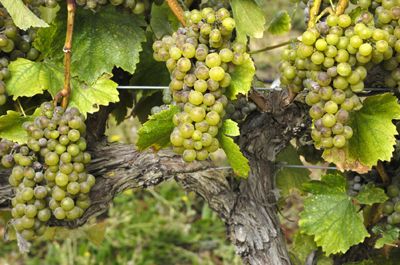When the Time’s Ripe

By Jessica Cortell
What is ripeness? Defined by birds, by the vine or by a winemaker?
For the winemaker, it’s the time when acids, sugars, anthocyanins, tannins and flavors converge in balanced harmony. This point is influenced by the winemaker’s preferences and winemaking style. Or sometimes, in Oregon, the harvest date is simply determined by the forecast of the start of the fall rains.
So far, this year is colder than last year, which was also one of the coldest years on record, so winemakers are highly motivated to get the fruit as ripe as possible. Can it be accomplished by pulling leaves in the fruit zone or by fruit thinning?
Increasing sunlight exposure in the fruiting zone through leaf removal has a number of well documented benefits, including reducing disease incidence, increasing sugars, lowering acids, improving flavor and aroma development, increasing biosynthesis of skin tannin and other phenolic compounds.
In a cool summer, removing leaves near the fruit as early as possible will provide the greatest benefit. This year growers have been experimenting with removing leaves before bloom instead of after fruitset and pulling leaves on both sides of the canopy — standard practice is to remove only leaves on the morning sun side but not on the afternoon side due to the risk of sunburn.
When the leaves are pulled early, the sunlight exposure can trigger the biosynthesis of flavonols, skin tannins and other phenolics. Flavonols function as grape sunscreen as they have UV protective qualities. These phenolics compounds found in skin contribute significantly to wine quality. While there might be a risk of sunburn on berries, this season the potential benefits of more extreme leaf pulling outweigh the risks.
Leaf pulling and managing excess vigor is extremely important in Bordeaux varieties (Cabernet Sauvignon, Cabernet Franc, Merlot) because of a group of flavor/aroma compounds called methoxypyrazines. These compounds are responsible for the vegetal, green bell pepper flavor found in “underripe” Cabernets or Merlots. They need to be managed in the vineyard as there are limited options for handling them in the winery. One challenge is the threshold for detection in red wines can be as low as 10 to 15 parts per trillion.
Yield is often discussed as having a direct relationship with fruit and wine quality. The benefits of crop thinning or yield adjustment are not always so clear in knowing under what situations to drop fruit, how much to drop and the advantages. There are also economic implications in reducing the crop when fruit is being sold by the ton.
Several studies show little to no influence on sugar accumulation even with cutting the crop in half. So yield adjustment simply to increase sugars carries only limited benefits. Numerous studies also show little impact on acids or pH. The benefits of fruit thinning are sometimes harder to define in precise terms as they involve improved phenolics, flavor and aromas.
In a cool climate and vintage where you want all possible advantages, making appropriate fruit thinning decisions can assist in producing high quality fruit. In terms of yield adjustment, the crop should be adjusted to fit the conditions, which include climate, vine age, rootstock, clone, site factors, drought stress, vine vigor and others.
A small crop on high vigor vines can result in delayed ripening while cropping young vines or vines with compromised canopy health can also prolong ripening. A balanced vine under moderate water stress with an appropriate crop load and a healthy canopy is the best bet to achieve fruit ripe.
There are different strategies and timing of fruit thinning. I like to keep yield adjustment separate from “qualitative” fruit thinning. As mentioned above, yield adjustment is done by determining an appropriate crop level for the vines. This is often determined by counting and weight clusters during the lag phase and multiplying by two to get an estimated harvest weight.
Last year in the Willamette Valley, there were small clusters and naturally low yields. Some people reacted to the cool season and thinned to one cluster per shoot, only to have very little fruit in the end by the time diseases and birds took some.
This year, very large clusters have been observed in most vineyards. At lag phase, they are already weighing the same as our final weights in 2010! This vintage one cluster per shoot makes more sense. Some clusters have an impressive 130 to 160 berries, while last year many had only around 70 berries per cluster. This is a huge difference in cluster size. The combination of large clusters and a cool vintage suggest careful yield adjustment.
Qualitative fruit thinning involves dropping flowers or fruit behind in ripening or have other issues such as disease or sunburn. This means pruning wings, thirds and short shoots as they usually bloom later and continue to delay ripening.
While sugar levels might be similar to the main cluster body, other aspects of ripening, such as color and flavor, are behind in the wings. By removing these wings and clusters, the average ripening date advances and the ripening curve tightened. Another type of qualitative fruit thinning is to come through when approximately 80 to 90 percent of the fruit has turned color. The fruit that is behind is still green and is easy to see and to drop on the ground.
In addition to yield adjustment, qualitative fruit thinning has benefits in promoting maximum ripeness. In a hot year, this may not be as beneficial. The combination of careful fruit thinning, good leaf removal to expose clusters and maintaining a healthy canopy are within our power to do … then all we can do is have a barbecue or two and hope for a beautiful September and October.












